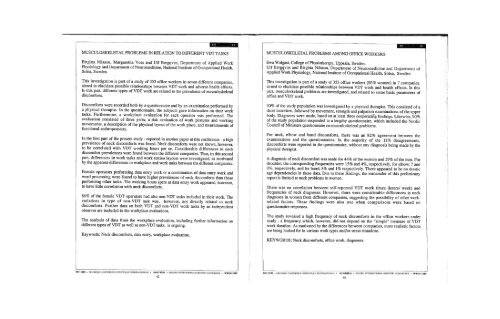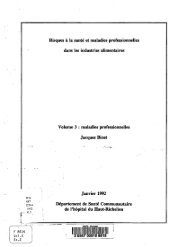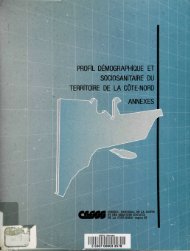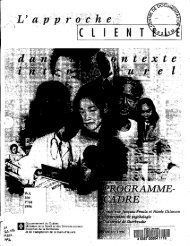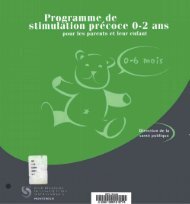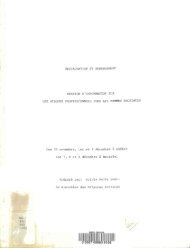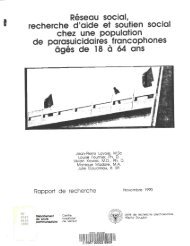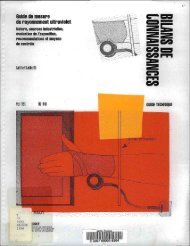TOWARD A THEORY OF TASKS AND DISPLAYSP.A. Hancock and J.O. Pierce, Department of Safety Science, Institute of Safety and SystemsManagement, University of Southern California, Los Ange<strong>le</strong>s, CA 90089-0021, U.S.A.The structure and characteristics of any <strong>display</strong> are critically <strong>de</strong>pen<strong>de</strong>nt upon the nature of the task andgoals that are sought by the user. Hence any theoretical frame<strong>work</strong> for <strong>display</strong>s must inclu<strong>de</strong> anun<strong>de</strong>rstanding of tasks and goals. The only essential goal of any system is self-perpetuation. However, forthe purposes of the present argument we <strong>de</strong>al <strong>with</strong> a subset of this generality and frame our discussionaround current and near future goals. Goals may be <strong>de</strong>fined as <strong>de</strong>sired future states of the system. If a goalis a <strong>de</strong>sired future state, a task is a subsidiary component that implies a specific transformation. Goals andtasks cannot be regar<strong>de</strong>d as mutually exclusive. For our present purposes, we can <strong>de</strong>fine goal achievementas composed of the successful and integrated comp<strong>le</strong>tion of more than one task, and by implication,comp<strong>le</strong>tion of a sing<strong>le</strong> task does not serve, alone, to achieve a system goal. A tasks transforms the state ofthe world at a point in time (to) to a later state (ti). It involves a reduction in local entropy and theexpenditure of energy toward a more or<strong>de</strong>red state. Temporal direction of the system is thus implied.Simp<strong>le</strong> temporal progression of a system <strong>with</strong>out alteration cannot be regar<strong>de</strong>d as a task <strong>with</strong>in this<strong>de</strong>finition. The cost of transformation, or <strong>de</strong>mand of any task may not be specified in vacuo (Sharit,1988). The characteristics and capabilities of the transformer must be specified in or<strong>de</strong>r to calculate cost. Inhuman performance such costs are typically expressed as a function of the time taken to traverse from state(t 0 ) to state (tj) and the accuracy of that transformation. Such costs are usually framed as values of thecurrent Zeitgeist (most recently in experimental psychology, as attentional costs or drains on attentionalresources).From the present perspective, attention explores a multi-dimensional (e.g., space-time), energy matrix. Itcan be conceived as a dynamic solution space in four dimensions. Within this matrix which is morecomp<strong>le</strong>x than simp<strong>le</strong> Minkowski space-time (because cognitive time and space are interlinked, nonorthogonal,and non-linear), there resi<strong>de</strong> a number of phenomena. Principal among are energetical andinformational landscape features such as attractors, repellors, and discontinuities. The purpose of any<strong>display</strong> is to present goals, and potential paths by which such goals may be achieved. A transparent<strong>display</strong> is one in which the present state and the goal state are given such that no operator-systemtransformation is necessary to accomplish success. A direct <strong>display</strong> is one in which the necessarytransformation, and the actions required to accomplish success are given in observer-based parameters,and the number of avenues for action typically asymptote quickly to a sing<strong>le</strong> solution. In contemporary ortransformational <strong>display</strong>s, multip<strong>le</strong> transformations are required between user, system, and task (see Card,1989), at which resources must be expen<strong>de</strong>d to generate homeomoiphic mappings between respective taskand goal representations. It is typically between such mappings that the basis for response error isgenerated. In princip<strong>le</strong> the presence of a <strong>display</strong> indicates the need for task simplification in that ecological<strong>display</strong>s may in principal provi<strong>de</strong> comp<strong>le</strong>te information for action. Displays are an admission that thelinkage between operator and system is incomp<strong>le</strong>te and that we have fai<strong>le</strong>d to integrate fully the capabilitiesand characteristics of each. Commonly, <strong>display</strong>s are not seen as failures but as necessary components oftechnical systems. Discussion in the present paper is directed toward the simplification of <strong>display</strong>s fromtheir present transformationally constrained format through direct to transparent <strong>display</strong>s. The implicationsfor systems, goals, tasks, and <strong>work</strong> <strong>de</strong>sign will be argued.KEY WORDS: Displays, Tasks, Theoretical IntegrationADAPTIVITY FACTORS FOR COMPUTER USEDianne Murray, Division of Information Technology and ComputingNational Physical Laboratory, Teddington, U.K. TW11 OLW.As screen-based computer systems become more pervasive in life and<strong>work</strong>, more and more naive users will be expected to interact <strong>with</strong> awi<strong>de</strong>r range of systems. Users, however, do form a diverse populationand there is a <strong>de</strong>mand for interfaces which can both adapt to the needsand requirements of many different users and to the growing skill andknow<strong>le</strong>dge of individual users. Designers at present provi<strong>de</strong> bespokeinterfaces for different applications but do not build mechanisms fordriving an adaptive or even customisab<strong>le</strong> system. A personal profi<strong>le</strong>held in some form of 'smart card' is one solution to the prob<strong>le</strong>m oftailoring systems to an individual's preferences but a full restructuringof the user interface management system is necessary to provi<strong>de</strong> suchapplications as co-operative advisers and intelligent training, help ormulti-user systems.The research reported will be a new taxonomy of <strong>le</strong>vels of adaptivitybased partly on Rasmussen's <strong>le</strong>vels of abstraction in human-computersystems. This helps to i<strong>de</strong>ntify the manner in which adaptiveinterfaces can be built and the mechanisms to be used in theirconstruction. Different types of user cognitive mo<strong>de</strong>ls are required forthe two major purposes of customisation and of adaptivity. It will beshown that a mo<strong>de</strong>l of a user termed an embed<strong>de</strong>d user mo<strong>de</strong>l isnecessary in the provision of such systems. The uses of this type ofmo<strong>de</strong>l are both as an integrating factor in the dialogue managementsystem and to maintain an intelligent know<strong>le</strong>dge-base about theindividual users of generic systems.Early results from a current research project into the specification of aUser Mo<strong>de</strong>lling Shell to produce the mo<strong>de</strong>ls i<strong>de</strong>ntified will be discussedand will be related to earlier experimental <strong>work</strong> on providing adaptiveinterfaces for small prototype applications.KEYWORDS: Adaptive interfaces, user mo<strong>de</strong>lling, embed<strong>de</strong>d usermo<strong>de</strong>ls.TEV 1989 — DEUXIÈME CONFÉRENCE SCIENTIFIQUE.INTERNATIONALE • MONTRÉAL • SECOND INTERNATIONAL SCIENTIFIC CONFERENCE — WWDU 1989TEV 1989 — DEUXIÈME CONFÉRENCE SCIENTIFIQUE INTERNATIONALE • MONTRÉAL • SECOND INTERNATIONAL SCIENTIFIC CONFERENCE — "WWDU 198913
MUSCULOSKELETAL PROBLEMS IN RELATION TO DIFFERENT VDT TASKSBirgitta Nilsson, Margaretha Yoss and Ulf Bergqvist, Department of Applied WorkPhysiology and Department of Neuromedicine, National Institute of Occupational Health,Solna, Swe<strong>de</strong>n.This investigation is part of a study of 353 office <strong>work</strong>ers in seven different companies,aimed to elucidate possib<strong>le</strong> relationships between VDT <strong>work</strong> and adverse health effects.In this part, different types of VDT <strong>work</strong> are related to the preva<strong>le</strong>nce of musculoske<strong>le</strong>taldiscomforts.Discomforts were recor<strong>de</strong>d both by a questionnaire and by an examination performed bya physical therapist. In the questionnaire, the subjects gave information on their <strong>work</strong>tasks. Furthermore, a <strong>work</strong>place evaluation for each operator was performed. Theevaluation consisted of three parts; a risk evaluation of <strong>work</strong> postures and <strong>work</strong>ingmovements, a <strong>de</strong>scription of the physical layout of the <strong>work</strong> place, and measurements offunctional anthropometry.In the first part of the present study - reported in another paper at this conference - a highpreva<strong>le</strong>nce of neck discomforts was found. Neck discomforts were not shown, however,to be correlated <strong>with</strong> VDT <strong>work</strong>ing hours per se. Consi<strong>de</strong>rab<strong>le</strong> differences in neckdiscomfort preva<strong>le</strong>nces were found between the different companies. Thus, in this secondpart, differences in <strong>work</strong> tasks and <strong>work</strong> station layouts were investigated, as motivatedby the apparent differences in <strong>work</strong>place and <strong>work</strong> tasks between the different companies.Fema<strong>le</strong> operators performing data entry <strong>work</strong> or a combination of data entry <strong>work</strong> andword processing were found to have higher preva<strong>le</strong>nces of neck discomforts than thoseperforming other tasks. The <strong>work</strong>ing hours spent at data entry <strong>work</strong> appeared, however,to have litt<strong>le</strong> correlation <strong>with</strong> neck discomforts.86% of the fema<strong>le</strong> VDT operators had also non-VDT tasks inclu<strong>de</strong>d in their <strong>work</strong>. Thevariations in type of non-VDT task was, however, not directly related to neckdiscomforts. Further data on both VDT and non-VDT <strong>work</strong> tasks by an in<strong>de</strong>pen<strong>de</strong>ntobserver are inclu<strong>de</strong>d in the <strong>work</strong>place evaluations.The analysis of data from the <strong>work</strong>place evaluation, including further information ondifferent types of VDT as well as non-VDT tasks, is ongoing.Keywords: Neck discomforts, data entry, <strong>work</strong>place evaluation.MUSCULOSKELETAL PROBLEMS AMONG OFFICE WORKERSEwa Wolgast, Col<strong>le</strong>ge of Physiotherapy, Uppsala, Swe<strong>de</strong>n.Ulf Bergqvist and Birgitta Nilsson, Department of Neuromedicine and Department ofApplied Work Physiology, National Institute of Occupational Health, Solna, Swe<strong>de</strong>nThis investigation is part of a study of 353 office <strong>work</strong>ers (80% women) in 7 companies,aimed to elucidate possib<strong>le</strong> relationships between VDT <strong>work</strong> and health effects. In thispart, musculoske<strong>le</strong>tal prob<strong>le</strong>ms are investigated, and related to some basic parameters ofoffice and VDT <strong>work</strong>.90% of the study population was investigated by a physical therapist. This consisted of ashort interview, followed by movement, strength and palpation examinations of the upperbody. Diagnoses were ma<strong>de</strong>, based on at <strong>le</strong>ast three cooperating findings. Likewise, 90%of the study population respon<strong>de</strong>d to a <strong>le</strong>ngthy questionnaire, which inclu<strong>de</strong>d the NordicCouncil of Ministers questionnaire on musculoske<strong>le</strong>tal prob<strong>le</strong>ms.For neck, elbow and hand discomforts, there was an 82% agreement between theexaminations and the questionnaires. In the majority of the 18% disagreements,discomforts were reported in the questionnaire, <strong>with</strong>out any diagnosis being ma<strong>de</strong> by thephysical therapist.A diagnosis of neck discomfort was ma<strong>de</strong> for 44% of the women and 29% of the men. Forshoul<strong>de</strong>r; the corresponding frequencies were 15% and 4%, respectively, for elbow; 7 and0%, respectively, and for hand; 8% and 1% respectively. There appeared to be no drasticage <strong>de</strong>pen<strong>de</strong>ncies in these data. Due to these findings, the remain<strong>de</strong>r of this preliminaryreport is limited to neck prob<strong>le</strong>ms in women.There was no correlation between self-reported VDT <strong>work</strong> times (hours/ week) andfrequencies of neck diagnoses. However, there were consi<strong>de</strong>rab<strong>le</strong> differences in neckdiagnoses in women from different companies, suggesting the possibility of other <strong>work</strong>relatedfactors. These findings were also true when comparisons were based onquestionnaire responses.The study revea<strong>le</strong>d a high frequency of neck discomforts in the office <strong>work</strong>ers un<strong>de</strong>rstudy - a frequency which, however, did not <strong>de</strong>pend on the "simp<strong>le</strong>" measure of VDT<strong>work</strong> duration. As motivated by the differences between companies, more realistic factorsare being looked for in various <strong>work</strong> types and/or stress situations.KEYWORDS: Neck discomforts, office <strong>work</strong>, diagnoses.TEV 1989 — DEUXIÈME CONFÉRENCE SCIENTIFIQUE INTERNATIONALE • MONTRÉAL • SECOND INTERNATIONAL SCIENTIFIC CONFERENCE — WWDU 198963TEV 1989 — DEUXIÈME CONFÉRENCE SCIENTIFIQUE INTERNATIONALE • MONTRÉAL • SECOND INTERNATIONAL SCIENTIFIC CONFERENCE — WWDU 1989125


